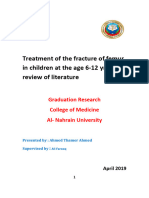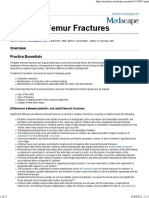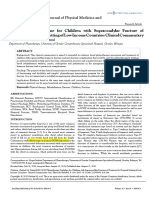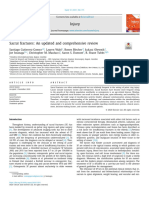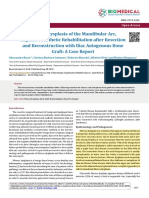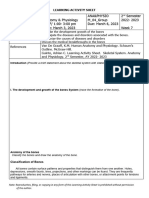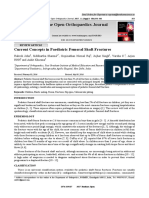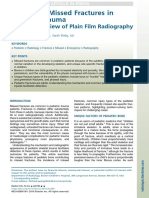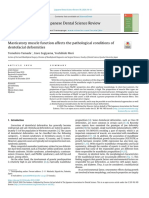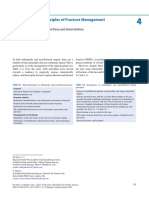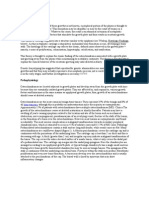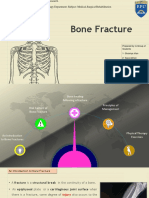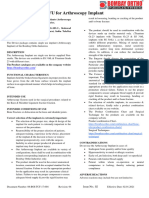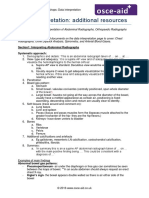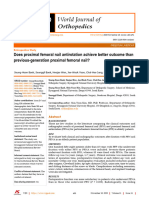Lesiones Fisarias
Uploaded by
Luisa Galicia ZamalloaLesiones Fisarias
Uploaded by
Luisa Galicia ZamalloaIndian Journal of Orthopaedics (2021) 55:525–538
https://doi.org/10.1007/s43465-020-00338-6
REVIEW ARTICLE
Management of Physeal Fractures: A Review Article
Vivek Singh1 · Varun Garg1 · Shital N. Parikh2
Received: 17 November 2020 / Accepted: 21 December 2020 / Published online: 13 January 2021
© Indian Orthopaedics Association 2021
Abstract
Background Physis is the weakest structure in the skeleton of a child and a frequent site of an injury or fracture. A physeal
fracture presents a unique challenge in the management as the sequalae of such an injury could lead to growth disturbances.
Methods In this review, mainly focussing on traumatic physeal injuries, the authors discuss the applied anatomy, different
fracture patterns, clinical assessment and management of physeal fractures in children.
Results Discussion on acute physeal injuries as well as physeal arrest and approach to its management is presented. Past
attempts for treatment of physeal injuries and recent advances in their management is also discussed.
Conclusion The ideal approach to treat physeal injuries should take into account the location of injury, age of the patient,
fracture type and growth potential of the involved physis. Prompt diagnosis and physeal-respecting treatment techniques
are important.
Keywords Physis · Fractures · Growth · Arrest · Management · Review
Introduction of the child as the sequalae of such an injury could lead to
growth disturbances. These growth disturbances could mani-
Physis (growth plate or epiphyseal plate) is the cartilaginous fest as limb length inequality or angular deformities. Of all
disc present at ends of a long bone and is responsible for the physeal fractures, growth arrest or disturbances are seen
the longitudinal growth of the bone in a child. Physis is the in 5–10% of the cases [2].
weakest structure in the skeleton of a child and is thus, a In this review, we discuss the applied anatomy of the phy-
frequent site of an injury or fracture. An injury which would sis, different physeal fracture patterns, clinical assessment
cause a ligamentous sprain of a joint in an adult, would of a child with physeal injury and management of physeal
cause a physeal fracture in a child. Several factors must be fractures. We briefly discuss physeal arrest and approach to
considered while evaluating a child with a physeal fracture its management. Lastly, we would review the past attempts
like the age of the patient, location of the physis, fracture for treatment of physeal injuries and recent advances in
type and growth potential of the involved physis [1]. A phy- their management. Although physeal injury can result from
seal fracture presents a unique challenge in the management infection, malignancy, metabolic abnormalities or iatrogenic
damage, the current review would be limited to traumatic
physeal injuries or physeal fractures.
* Shital N. Parikh
[email protected] Incidence
Vivek Singh
[email protected] Physeal fractures account for 30% of all the paediatric
Varun Garg fractures [3]. These fractures are more common in adoles-
[email protected] cence as in a younger child, the epiphysis is more cartilagi-
1
nous and acts as a shock absorber with significant amount
Department of Orthopaedics, All India Institute of Medical
Sciences, Rishikesh, India
of forces been transmitted to the metaphysis [4]. Boys are
2
affected twice as often as girls as their physis remain open
Department of Orthopaedic Surgery, Cincinnati Children’s
Hospital Medical Center, University of Cincinnati College
till a later age and they may be more susceptible to trauma
of Medicine, 3333 Burnet Avenue, Cincinnati, OH 45229, due to increased sports participation [3, 5–7]. Regardless
USA
13
Vol.:(0123456789)
526 Indian Journal of Orthopaedics (2021) 55:525–538
of the site, distal physis are more commonly involved than of periosteum and provides mechanical support to the phy-
the proximal physis with distal radial physis as the most sis [4].
frequent site to be involved followed by distal tibial physis
[3, 5–7]. Microstructure
Physis is made up of hyaline cartilage and it consists of
Applied Anatomy chondrocytes organized in columns along the long axis
of the bone. It is divided into four zones from epiphysis
To effectively manage physeal fractures, it is essential to metaphysis: Germinal, Proliferative, Hypertrophic and
to understand the anatomy of the physis (Fig. 1). Long Endochondral Ossification. The germinal layer includes
bone development begins at 6th week of intrauterine life chondrocytes in somewhat inactive state. The proliferative
as condensation of the mesenchymal anlage. By 8 weeks, layer includes chondrocytes that undergo rapid mitotic divi-
a primary ossification centre develops in the middle of sion and are organized in stacked columns. These two layers
long bones. The primary ossification centre grows by are rich in extracellular matrix and collagen fibres and are
endochondral ossification and extends towards the end of therefore able to resist shearing forces [11]. In the hyper-
the long bones. On radiographs, the physis is visible as a trophic zone, the chondrocytes lose their ability to proliferate
radiolucent zone separating the metaphysis and epiphysis and differentiate in to mature chondrocytes with increased
at the end of long bones. It is also referred to as meta- cell volume. The extracellular matrix and amount of col-
physeal or primary physis. This is to distinguish it from lagen fibres are negligible. Therefore, hypertrophic zone is
articular [8] or secondary physis [9] which is responsible weaker in comparison to other zones and most of the physeal
for growth of the secondary ossification centre of the epi- fractures occurs through this layer. In the zone of provisional
physis towards the joint. The word ‘physis’, by default, calcification, the chondrocytes undergo apoptosis and the
refers to the primary physis. Relative contribution of dif- cartilaginous matrix begins to calcify. These islands of calci-
ferent physis to longitudinal growth and absolute amount fied cartilage act as scaffold for new bone formation, facili-
of growth per year is given in Fig. 2. tated by invasion of capillaries from the metaphysis. The
The periphery of the physis is attached securely to the osteoclasts and osteoblasts from the metaphysis break down
metaphysis through the Zone of Ranvier and Ring of LaC- the calcified cartilage and replace it with mineralized bone.
roix. The Zone of Ranvier is a groove around the periphery Physeal injuries heal faster than bony injuries. Typically,
of the physis that contains chondrocyte progenitor cells a physeal fracture would heal in 3–4 weeks. However, in
and is responsible for the circumferential growth of the case of an injury to a large undulating physis, like distal
physis [10]. The Ring of LaCroix is a fibrous continuation femur physeal fracture, the fracture plane would traverse
through various zones of the physis. Likewise, intra-articular
Fig. 1 Structure of physis
(Source: Mallick A, Prem
H. Physeal injuries in chil-
dren. Surgery (Oxford). 2017
Jan;35(1):10–7.)
13
Indian Journal of Orthopaedics (2021) 55:525–538 527
Fig. 2 Relative contribution
to growth by various physis
(Source:Lippincott Williams
& Wilkins from Lovell and
Winter’s Pediatric Orthopedics,
Morrissy R.T. and Weinstein,
S.L. (Eds), 2005)
physeal fractures, like Salter–Harris (SH) type III and IV ossification. The perichondrial ring of LaCroix supplies the
fractures, would traverse through various or all zones of the periphery of the physis. It is evident from the above discus-
physis. Such injuries have worse prognosis as the chances sion that hypertrophic zone remains relatively avascular.
of bone formation across the physis increases when multiple
zones are injured. Classification
Blood Supply The most widely used classification system for physeal frac-
tures is the Salter and Harris classification system, (Fig. 4)
Knowledge of the blood supply in and around the physis is which divides the physeal injuries into five types. [14] This
necessary to understand the consequences of physeal frac- classification system helps guide the treatment as well as
tures. Physis receives its predominant blood supply from the prognosticate the facture pattern. Types I and II are extra-
epiphysis (Fig. 3a). Other sources of blood supply are from articular fractures with good prognosis. These fractures
the metaphysis and the perichondrial ring [13]. Epiphyseal mostly occur through the hypertrophic zone of the physis
circulation essentially supplies the germinal and proliferative and have significantly lower rates of physeal arrest. Types
layers of the physis. It is further divided into two types by III and IV are intra-articular fractures that would typically
Dale and Harris (Fig. 3b) [12]. In type A, the epiphysis is involve various or all layers of the physis with increased
entirely covered by articular cartilage and receives its blood potential for physeal arrest. Type V fractures are diag-
supply from vessels that enter the epiphysis by traversing the nosed in retrospect after the occurrence of growth arrest
perichondrium at the periphery of the plate. Thus, physeal and deformity. Rang added a type VI fracture that involved
separation or injury, as in femoral neck physeal fracture, the periphery of the physis, including the perichondral ring
could lead to destruction of the blood supply to the epiphysis (Fig. 4) [15]. This injury and loss of peripheral physis is
and resultant avascular necrosis. In type B, the epiphysis is typically seen around an open injury to the medial malleolus.
partially covered by articular cartilage and receives its blood Peterson described a classification system in which the ini-
supply by vessels that directly penetrate the epiphyseal cor- tial four types of Salter–Harris classification were retained
tex at areas that are not covered by articular cartilage. Thus, while adding two new types (Fig. 4) [9].
physeal injury would lead to temporary interference with
endochondral ossification marked by increased thickness of Imaging
the physis, followed by rapid healing within 3–4 weeks.
The metaphyseal circulation comes from the branches of The initial investigation usually done to diagnose physeal
nutrient artery and they supply the zone of endochondral injuries are plain radiographs. The radiographs should
13
528 Indian Journal of Orthopaedics (2021) 55:525–538
Fig. 3 a Blood supply to physis
and b types of epiphyseal blood
circulation to physis (Image
Source: Mallick A, Prem
H. Physeal injuries in chil-
dren. Surgery (Oxford). 2017
Jan;35(1):10–7.)
include two orthogonal views and should focus on the site variants mimic fractures, contralateral radiographs can help.
of fracture to appreciate the true injury pattern and dis- Sometimes, an oblique view is required to better portray the
placement. It is not recommended to evaluate distal radius fracture pattern, as in the internal rotation oblique view to
physeal fractures on forearm radiographs or ankle physeal evaluate fracture of lateral condyle of distal humerus. Stress
injuries on full leg radiographs. The extent of injury would views are not recommended as it can displace the fracture,
be unappreciated on such views due to parallax, image dis- can cause iatrogenic injury to the physis and can cause sig-
tortion, magnification errors and inadequate visualization. nificant discomfort to the patient.
Other radiographs should incorporate a joint above and joint Although MRI can be used to diagnose occult physeal
below the site of injury. When in doubt or when ossification fractures, its value and usefulness in paediatric trauma is
13
Indian Journal of Orthopaedics (2021) 55:525–538 529
Fig. 4 Classification of physeal fractures (Images source: Mallick A, Prem H. Physeal injuries in children. Surgery (Oxford). 2017 Jan;35(1):10–
7.)
13
530 Indian Journal of Orthopaedics (2021) 55:525–538
limited. Gulfer et al. detected occult physeal fractures around gap or step-off, but also aids in the placement of percu-
the elbow, ankle and knee in 8 of the 23 patients (34%) who taneous fixation by delineating the chondral surface. An
presented with clinical symptoms and signs of injury, but arthrogram can be performed for any joint to evaluate the
had negative radiographs [16]. MRI is recommended for articular surface, but is more commonly used around the
evaluation of traumatic haemarthrosis of a joint without an elbow joint.
apparent fracture. For example, TRASH (The radiographic Partial or complete growth arrest is one of the most sig-
appearance seemed harmless) lesions of the elbow joint nificant complication of a physeal fracture. Partial arrest
would be a primary indication for MRI [17]. MRI can also is classified into: central, peripheral, linear or combined
be helpful for assessment of chondral/osteochondral injuries depending upon the location of physeal bar (Fig. 5). It
and ligament injuries of major joints [18–21]. is essential to assess the exact location and size of the
CT scan is recommended for delineation of fracture physeal bar and estimate remaining growth, to help formu-
lines and for preoperative planning for intraarticular phy- late management decisions [27]. Plain radiographs of the
seal fractures, mainly around the knee and the ankle [22]. involved and contralateral uninvolved physis can provide
In a study comparing CT scan and radiographs of triplane general information about the physeal bar. Serial plain
ankle fractures, the CT scan changed the diagnosis in 46%, radiographs can be used to evaluate for any developing
changed the treatment plan in 27% and changed the number deformity or limb length discrepancy. A left-hand bone
and trajectory of the screws in 41% patients, as compared to age radiograph can help to estimate remaining growth.
radiographs [23]. Thus, CT scan can help to delineate intra- For assessment of the physeal bar, a CT scan can help to
articular fracture geometry and aid in treatment planning. determine the exact location and size of the bony bar and
Besides this, CT scan can be used for 3D assessment of create physeal bridge map. The drawbacks of CT scan are
complex injury patterns or their sequelae, i.e. growth arrest, that it does not provide information about a fibrous bar
deformity or malunion [24, 25]. or about health of the remaining physis [28]. Moreover,
Intraoperatively, an arthrogram can provide valuable there is a small risk of radiation to the children. MRI is the
information by outlining the largely cartilaginous articular imaging modality of choice for assessment of physeal bar
surfaces and is routinely used in paediatric trauma [26]. and specialized software or manual calculation can help
It not only provides information about articular surface to map the area of physeal arrest [29].
Fig. 5 Classification of physeal bar (Images source: Mallick A, Prem H. Physeal injuries in children. Surgery (Oxford). 2017 Jan;35(1):10–7.)
13
Indian Journal of Orthopaedics (2021) 55:525–538 531
Principles of Management of Physeal Injuries (transphsyeal), compression should be avoided. If more
than 2 years of growth is remaining, the transphyseal
The following principles are recommended to manage phy- implant should be removed once the fracture is healed.
seal injuries in children with some modifications depending 5. There are several methods for assessment of accuracy
upon location of injury and age of the child. of articular surface fracture reduction for SH 3 and 4
physeal fractures. These include direct visualization,
1. Displaced physeal fracture should be reduced with fluoroscopy, arthrogram or arthroscopic assessment.
sustained traction and gentle manipulation. Forceful 6. Resecting a small portion of periosteum on either side
reduction manoeuvres, repeated attempts of reduction of the physis during an open reduction of fracture may
or insertion of instrument in to the physis to manipu- help to reduce the risk of bony bar formation, although
late fracture fragments should be avoided as it could this is controversial [22].
grate the physis and cause iatrogenic physeal injury. 7. For an exposed or crushed physeal injury, an acute or
Open reduction is better than multiple attempts at anticipatory Langenskiold procedure (use of free fat
closed reduction. graft to cover the physis) can be performed to help
2. For an extra-articular physeal fracture (SH 1 and 2) prevent growth arrest [30, 31].
delayed reduction attempts beyond 5 days after injury 8. Most physeal fractures heal in 3–4 weeks.
should be avoided. Such attempts could lead to iat- 9. Growth arrest lines (Park–Harris lines) are transverse
rogenic physeal injury and resultant growth arrest. lines seen in the metaphysis (Fig. 6). Their orientation
Instead, it is better to allow the fracture to heal and and relationship to the physis are used to assess growth
remodel. Management of malunion is relatively easier and growth disturbances [32, 33].
than management of growth arrest in a young patient. 10. For a displaced physeal fracture, the patient should be
3. Intra-articular displaced physeal fractures (SH 3 and 4) monitored for growth disturbances for at least a year or
should be reduced anatomically and stabilized by inter- until the patient is skeletally mature. For undisplaced
nal fixation, irrespective of their time of presentation. physeal fracture, there is no need for serial radio-
Articular surface congruity and reduction is of utmost graphs. Instead, the family should be counselled about
importance. The reduction can be achieved by closed, low potential for growth arrest and to follow-up if any
arthroscopic or an open approach. symptoms or deformity are noticed.
4. Implants used for internal fixation should be placed in
a physeal-respecting manner. They should be placed
parallel to the physis when the fracture geometry
allows for it. If an implant is placed across the physis
Fig. 6 Growth arrest lines nor-
mal and abnormal Park–Harris
(PH) lines. a Arrows point to
normal PH lines which are par-
allel to physis. b Dashed arrow
points to area of physeal arrest.
PH line is not parallel to the
physis and coverages towards
the area of growth arrest
13
532 Indian Journal of Orthopaedics (2021) 55:525–538
Iatrogenic Physeal Injury within the physis, use of threaded pins, and increased
duration of retention of pin in the physis [38]. Smith
Iatrogenic injuries to physis can be caused by forceful et al. showed that the use of temporary transphyseal pin-
reduction manoeuvres or due to placement of periphyseal ning in juxtaphyseal fractures of upper limb, resulted
or transphyseal implants (Fig. 7). At times, it is difficult to in physeal arrest in 1 out of 5 patients on MRI evalua-
differentiate iatrogenic injuries from the initial injury insult. tion at 6 months after the removal of K-wire [41]. Thus,
Physeal arrest (SH V) has been reported after metaphyseal transphyseal K-wires should be used judiciously across
and diaphyseal fractures not involving the physis [34]. Simi- the physis and multiple K-wires, multiple attempts
larly, inadvertent physeal injuries can occur during routine at insertion of K-wires, large-size K-wires, intrafocal
treatment of metaphyseal and diaphyseal fractures. Several K-wires and permanent K-wires should be avoided.
factors decide the fate of physis after an initial injury. • Intramedullary Nails: Piriformis entry of intramedullary
rigid nail for treatment of femoral diaphyseal fractures
• Forceful and repeated manipulation of physeal fracture in children can lead to avascular necrosis of the femoral
could lead to increased physeal damage. For extra-artic- head (due to vascular injury) or coxa valga (due to injury
ular physeal fractures, satisfactory alignment of the frac- to the medial aspect of trochanteric apophysis). This has
ture fragments is acceptable rather than forceful attempts been observed in 30% of the cases in one series [42].
to achieve anatomic reduction. Physeal gap of up to 3 mm This did not depend upon the dimension and duration of
may be due to periosteal interposition in the fracture retention of nail [43]. Another study showed that physeal
fragment. It is not necessary to remove this interposition arrest developed in three out of the eight patients fol-
as it has not shown to affect the rate of premature physeal lowing nailing due to reaming [44]. Trochanteric entry
closure [35]. If the fracture fragments cannot be aligned or lateral entry nail have shown to minimize such com-
and there is persistent deformity after reduction attempts, plications. Other authors showed favourable result with
then open reduction should be performed to remove any nailing when the nail was placed in the centre of the
tissue interposition. physis and diameter of the nail was small in relation to
• K-wires: several animal studies have shown a correlation the physis [45]. Similarly, injury to distal femoral phy-
between transphyseal pinning and growth disturbances sis could happen during placement of retrograde flexible
[27, 36, 37]. Premature physeal arrest has been reported intramedullary nails. It is recommended that insertion
after pinning of distal radius fracture by several authors point for such nails should be in the metaphysis and dis-
[38–40]. Boyden and Peterson observed that premature section should be avoided in the area of the physis during
physeal closure was potentially related to pin size, loca- nail placement.
tion of the pin within the physis, obliquity of the pin
Fig. 7 An example of iatrogenic physeal arrest following ORIF of tib- would lead to iatrogenic growth disturbances. This could be poten-
ial tubercle fracture-Physeal arrest could be due to primary injury but tially prevented by the removal of screws after fracture healing
keeping screws across physis after fracture healing in a growing child
13
Indian Journal of Orthopaedics (2021) 55:525–538 533
• Threaded pins and screws: threaded pins and screws bar occupying up to 50% of physeal area could be success-
across the physis are avoided due to potential risk of fully removed, 30% seems to be a threshold based on the
premature physeal closure except in some instances. For recent reports and authors experience. Similarly, the general
example: threaded K-wires/Steinmann pins are used for indications for hemiepiphysiodesis and osteotomy have been
fixation of displaced proximal humerus physeal frac- listed here as > 5° and > 10° of deformity, respectively. This
tures. Smooth K-wires have shown to migrate when may vary based on the physis, remaining growth and physi-
used around the shoulder area as early as 5 days after cian–patient–family shared decision. [58].
placement, and may end up in vital structures (lungs,
heart, vessels, mediastinum) and could be fatal [46]. Past Attempts and Recent Advances in Management
When threaded implants are placed across the physis, it of Physeal Injuries
is recommended to remove these implants after fracture
healing. • Acute Langenskiold procedure Langenskiold popularized
the method of free fat graft interposition after resection
Principles of Management of Physeal Arrest of partial physeal arrest. The fat graft would prevent ref-
ormation of the bony bridge. Similar concept could be
Physeal arrest (bony bar, physeal bar, bony bridge) leading used in an acute setting. With high-risk fractures, like
to growth disturbances occurs in about 5–10% of physeal SH IV and VI, when the physis is crushed or exposed,
fractures [2]. Growth disturbances are always a possibility an acute Langenskiold procedure can help prevent a bony
after injuries around the physis and the family should be bar [31]. Foster et al. reported two cases of SH IV frac-
counselled about it at the start of the treatment and the infor- ture and one case of SH VI fracture treated with acute
mation should be reinforced periodically during follow-up. free fat grafting over the exposed physis. Based on their
The follow-up radiographs should be carefully scrutinized excellent results and success in prevention of bone bridge
to detect early signs of growth disturbances. An anatomic formation, the authors recommended a definite role for
reduction, with or without internal fixation, does not guar- an anticipatory Langenskiold procedure in the manage-
antee against a growth arrest. Management of physeal arrest ment of acute high-risk physeal injury [30]. Recently,
would depend on the physis involved (location and extent), Abbo et al. reported on an SH VI fracture of distal tibia in
type of bony bar (location and size), growth remaining and an 11-year-old boy, where an anticipatory Langenskiold
existing or expected deformity/limb-length discrepancy [47, procedure was performed successfully using bone cement
48]. instead of fat graft [59].
Minor disturbances in physis are seen in a high percent- • Interposition materials They are used after bony bar
age of physeal injuries, but may not require any treatment resection in order to prevent accumulation of blood in
except for observation. Several animal studies have con- the cavity which can lead to recurrence of bar formation.
cluded that injury to 7–10% of the physis did not result in Various interposition material used are fat, polymethyl-
permanent growth arrest and may not require any treatment methacrylate (PMMA), silastic, cartilage, bone wax and
[49–51]. On rare occasion, a small bony bar may break due dura. Fat and PMMA are the two most commonly used
to continuous longitudinal growth of the uninjured physis interposition materials [9]. Fat has the advantage that it’s
[52]. This would typically occur in younger patients when nonimmunogenic and can be harvested locally. The dis-
the physis has significant growth potential. Sometimes, the advantage is that it is not haemostatic and tends to float
physeal bar may resolve spontaneously [53–56]. An atypi- out of the cavity when the raw bone surfaces bleed after
cal incomplete bar (forme fruste bar) due to cartilaginous the removal of bony bar. Application of either thrombin
aberration may be seen after physeal fracture. It is due to or bone wax can provide haemostasis and help prevent
increased production of physeal cartilage which could tem- fat migration. The other option is to suture the fat to the
porarily tether the growth and cause growth disturbances. epiphysis and metaphysis using drill holes. Langenkiold
Possible explanation for this phenomenon is temporarily ces- recommended suturing ligament, muscle or subcutaneous
sation of blood flow to the metaphysis delaying the invasion tissue over the fat to prevent migration [60, 61]. Another
of the cartilage columns in the hypertrophic zone by the vas- disadvantage of fat is that it does not provide structural
cular and bone forming activities of the zone of provisional support to the weakened bone, thereby predisposing the
calcification [57]. bone to pathologic fracture. Thus, postoperative immo-
The principles of management of physeal arrest are sum- bilization and limited weight bearing may be required
marized in Fig. 8. This is a simplified flowchart to help [62]. Lastly, fat cells can undergo degradation or necrosis
with complex decision-making process. Assessment of the that can lead to recurrence of bony bar formation [63].
remaining growth is based on the skeletal age and not chron- PMMA without barium (Cranioplast) has several desir-
ological age. Although it has been reported that a physeal able characteristics like being inexpensive, minimally
13
534 Indian Journal of Orthopaedics (2021) 55:525–538
PHYSEAL ARREST
>2 YEAR GROWTH REMAINING < 2 YEAR GROWTH REMAINING
< 30% > 30% OBSERVATION
BAR RESECTION EPIPHYSIODESIS DEVELOPING DEFORMITY SKELETAL MATURITY
+/- HEMIEIPHYSODESIS +/- OSTEOTOMY
(IF DEFORMITY >5 o) ( IF DEFORMITY > 10o)
+/- OSTEOTOMY
(IF>100 DEFORMITY)
UNSUCCESSFUL ESTIMATED LLD
< 2 CM 2-5 CM > 5 CM
OBSERVATION CONTRALATERAL LIMB
EPIPHYSODESIS LENGHTENING
Fig. 8 Flowchart showing principles of management of physeal arrest
thermogenic, easily available, inert, haemostatic and tion led to the formation of a scar-like tissue instead of a
radiolucent. It can provide structural support after bone bone bridge [66]. In a porcine model of distal femur phy-
bridge resection and thus early weight bearing could be seal injury, Abood et al. reported that fibrin alone could
initiated [64]. When used as an interposition material, prevent formation of bone bridge in 4 of 5 specimens
PMMA should be tethered to the epiphysis to prevent it and was more effective than fat as interposition mate-
from migrating into the metaphysis. This can be achieved rial. When fibrin was mixed with autologous articular
by creating drill holes in the epiphysis, using K-wire cartilage, the mixture prevented bone bridge formation
through the epiphysis and PMMA or by undermining in all specimens [67]. Thus, fibrin appears to be an attrac-
the epiphyseal walls to create PMMA plug anchor. tive, readily available, alternative to other interposition
• Fibrin (fibrin glue, fibrin sealant) is routinely used for its materials although its clinical results are lacking.
haemostatic and surgical sealing properties and is easily • Physeal distraction Symmetric distraction of physis by
available in the market. Its role in prevention of bony an external fixator has been used for bone lengthening in
bar has been explored in animal models. Besides mini- children [68, 69]. In animal studies, the rate of distraction
mizing bleeding at the site of physeal injury, it can cre- had an effect on the fate of the physis as rapid distrac-
ate a microenvironment that is suitable for chondrocyte tion (1 mm per day) led to ossification and closure of the
induction and conduction [65]. Jie et al. reported that physis but slow distraction (0.25 mm twice a day) main-
fibrin could effectively inhibit bony bar formation in a tained the normal physeal thickness and growth poten-
proximal tibia physeal injury rat model. Fibrin applica- tial [70]. These principles have been applied to post-
13
Indian Journal of Orthopaedics (2021) 55:525–538 535
traumatic physeal bar and resultant growth deformities. grafts, inadequate vascularity and nutrition could lead
Slow, asymmetric physeal distraction could potentially to ischaemia and death of the physis [80]. To obviate
break the physeal bar and allow for deformity correc- the issue of limited donor site availability, physis allo-
tion followed by normal physeal growth. Aldegheri et al. graft transplantation has been studied in animal mod-
reported on 35 lower extremity post-traumatic deformi- els. Microvascular transplantation of physeal allograft
ties and their best results were achieved when the bone is appealing but its use restricted due to lack of data
bridge occupied less than 20–30% of the physis [71]. on the survival of cartilage cells in the physis and the
Canadell and De Pablos reported on eight cases with risk of immunogenic reaction in the host, which would
bony bar and deformities affecting the lower extremi- require immunosuppressive therapy [81].
ties. They reported adequate correction with physeal • Regenerative and tissue-engineering approaches Various
distraction without the need for resection of the bone studies have proposed newer approaches which suggests
bridge [72]. Bollini et al. reported successful treatment that, not only the bony bar formation be prevented but
of a centrally located bony bridge of the lower tibia using can also be regenerated to healthy physis. Autologous
distraction by Ilizarov technique [73]. chondrocytes embedded in scaffolds have been success-
The main drawback of this technique is the variable fully integrated into growth plate in animal models [82,
rate of physeal growth after distraction with reports 83]. However, their use may be limited by the need to
of growth disturbances and premature physeal closure isolate chondrocytes from normal tissues, thus creating
ranging from 0 to 100% [74, 75]. Hence the procedure secondary injury sites. To counter this, mesenchymal
is reserved for those near skeletal maturity. Other com- stem cells (MSCs) from periosteum and bone marrow
plications include pin site infections, joint stiffness and have been used. These MSCs resulted in native like repair
sudden increase in pain due to breakage of bone bar. tissue in animals [84]. To promote cartilage differentia-
• Physeal transplantation An alternative to the treatment tion of cells, chondrogenic factors such as IGF-1, TGF
of physeal bar would be to exchange it with normal BETA-1 and 2 are commonly used [85]. For cells and
functioning physis to produce meaningful growth. The chondrogenic molecules to have an effect at the site of
physeal transplant could be an autograft or allograft physeal injury, they have to be delivered locally by a tem-
and it could be vascularized or non-vascularized. Auto- porary scaffold. Commonly used scaffolds are collagen
graft availability of physis is significantly limited by I and II, hyaluronate–collagen–fibrin composites, Col-
lack of donor site in the body. Possible donor sites for lagen chitin scaffolds, agarose, chitin, gelatin and PLGA.
physeal cartilage include proximal fibula, distal ulna, Another potential approach is to modulate the pathways
distal clavicle, phalanx, toe, costal cartilage or iliac that stimulate osteogenesis. Bevacizumab, a humanized
crest apophysis. The physis could be transplanted as a anti-VEGF antibody, showed reduction in osteogenic
bone block (containing sliver of epiphysis and meta- gene expression, fewer blood vessels, and decreased
physis with intervening physis), as the end of a bone bony bar formation [86]. Other pathways which have
containing physis or as part or whole physeal plate been studied include Wnt/β catenin. Inhibition of this
without bone. Mayr et al. reported on 3-year follow-up pathway in rat models have led to decreased bony bar
of successful reconstruction of medial malleolus defect formation [87]. Thus, the field of regenerative medicine
in a 10-year-old boy using iliac crest apophyseal carti- holds a lot of promise for the future.
lage and physeal transplant [76]. Gigante and Martinez
reported on 4-year follow-up of a successful case of
excision of bone bridge from distal radius physis in
a 12-year-old boy and replaced it with an autologous Conclusion
block from iliac crest apophysis [77]. The cartilagi-
nous transplant was oriented such that the bony part of Physeal fractures are common. The ideal approach to treat
the iliac crest was placed against the metaphysis of the these injuries depends on thorough understanding of prin-
radius. Despite clinical case reports and encouraging ciples of physeal fracture management, taking into account
animal study results, physeal transplant is not popular the location of injury, age of the patient, fracture type and
as the results are unpredictable. The donor site is lim- growth potential of the involved physis. Prompt diagnosis
ited and the donor physis retains its growth potential and physeal-respecting treatment techniques are important
which may be different from the growth rate of the but may not be sufficient to prevent future physeal growth
recipient site [78, 79]. The physis has to fit exactly at arrest and resultant growth disturbances. Family counsel-
the recipient site so that the metaphysis and epiphy- ling and careful vigilance would help in identification and
sis are aligned appropriately. Slight mismatch could management of such growth disturbances should they occur.
lead to bony bar formation. For non-vascularized
13
536 Indian Journal of Orthopaedics (2021) 55:525–538
Compliance with Ethical Standards 17. Waters, P. M., Beaty, J., & Kasser, J. (2010). Elbow, “TRASH”
(the radiographic appearance seemed harmless) lesions. Journal
of Pediatric Orthopedics, 30, S77-81.
Conflict of interest The authors declare that they have no confict of
18. Rathjen, K. E., & Birch, J. G. (2006). Physeal injuries and growth
interest.
disturbances (6th ed., pp. 99–131). Philadelphia: Lippincott Wil-
liams & Wilkins.
Ethical standard statement This article does not contain any study
19. Boutis, K., Narayanan, U. G., Dong, F. F., Mackenzie, H., Yan, H.,
with human participants performed directly by any authors for this
Chew, D., et al. (2010). Magnetic resonance imaging of clinically
particular paper.
suspected Salter–Harris I fracture of the distal fibula. Injury, 41,
852–856.
Informed consent For this type of study informed consent is not
20. Carey, J., Spence, L., Blickman, H., & Eustace, S. (1998). MRI
required.
of pediatric growth plate injury: correlation with plain film radio-
graphs and clinical outcome. Skeletal Radiology, 27, 250–255.
21. Havránek, P., & Lízler, J. (1991). Magnetic resonance imaging
in the evaluation of partial growth arrest after physeal injuries in
children. J Bone Joint Surg Am, 73(8), 1234–1241.
References 22. Parikh, S. N., Wells, L., Mehlman, C. T., & Scherl, S. A. (2011).
Management of fractures in adolescents. Instructional Course
1. Dodwell, E. R., & Kelley, S. P. (2011). Physeal fractures: basic Lectures, 60, 397–411.
science, assessment and acute management. Orthopaedics and 23. Eismann, E. A., Stephan, Z. A., Mehlman, C. T., Denning, J.,
Trauma, 25(5), 377–391. Mehlman, T., & Parikh, S. N. (2015). pediatric triplane ankle
2. Kawamoto, K., Kim, W. C., Tsuchida, Y., Tsuji, Y., Fujioka, M., fractures: Impact of radiographs and computed tomography on
Horii, M., et al. (2006). Incidence of physeal injuries in Japa- fracture classification and treatment planning. Journal of Bone
nese children. Journal of Pediatric Orthopedics Part B, 15(2), and Joint Surgery American Volume, 97(12), 995–1002.
126–130. 24. Thawrani, D., Kuester, V., Gabos, P. G., Kruse, R. W., Littleton,
3. Mann, D. C., & Rajmaira, S. (1990). Distribution of physeal and A. G., Rogers, K. J., et al. (2011). Reliability and necessity of
nonphyseal fractures in 2650 long-bone fractures in children aged computerized tomography in distal tibial physeal injuries. Journal
0–16 years. Journal of Pediatric Orthopedics, 10(6), 713–716. of Pediatric Orthopedics, 31(7), 745–750.
4. Bright, R. W., Burstein, A. H., & Elmore, S. M. (1974). Epiphy- 25. Wuerz, T. H., & Gurd, D. P. (2013). Pediatric physeal ankle frac-
seal-plate cartilage. A biomechanical and histological analysis of ture. Journal of the American Academy of Orthopaedic Surgeons,
failure modes. Journal of Bone and Joint Surgery America, 56(4), 21(4), 234–244.
688–703. 26. Vorhies, J. S., Funk, S., Elliott, M., Riccio, A., & Ramo, B. (2020).
5. Rennie, L., Court-Brown, C. M., Mok, J. Y. Q., & Beattie, T. F. The utility of intraoperative arthrogram in the management of
(2007). The epidemiology of fractures in children. Injury, 38(8), pediatric lateral condyle fractures of the humerus. Orthopedics,
913–922. 43(1), 30–35.
6. Ogden, J. A. (2000). Skeletal injury in the child (3rd ed.). New 27. Escott, B. G., & Kelley, S. P. (2012). Management of traumatic
York: Springer. physeal growth arrest. Orthopaedics and Trauma, 26(3), 200–211.
7. Ogden, J. A. (1981). Injury to the growth mechanisms of the 28. Young, J. W. R., Bright, R. W., & Whitley, N. O. (1986). Com-
immature skeleton. Skeletal Radiology, 6(4), 237–253. puted tomography in the evaluation of partial growth plate arrest
8. Byers, P. D., & Brown, R. A. (2006). Cell columns in articular in children. Skeletal Radiology, 15(7), 530–535.
cartilage physes questioned: a review. Osteoarthritis Cartilage, 29. Lurie, B., Koff, M. F., Shah, P., Feldmann, E. J., Amacker, N.,
14(1), 3–12. Downey-Zayas, T., et al. (2014). Three-dimensional magnetic
9. Peterson, H. A. (2007). Epiphyseal growth plate fractures (2007th resonance imaging of physeal injury: reliability and clinical util-
ed.). Berlin: Springer. ity. Journal of Pediatric Orthopedics, 34(3), 239–245.
10. Langenskiöld, A. (1998). Role of the ossification groove of Ran- 30. Foster, B. K., John, B., & Hasler, C. (2000). Free fat interposi-
vier in normal and pathologic bone growth: a review. Journal of tional graft in acute physeal injuries: The anticipatory Langenski
Pediatric Orthopedics, 18(2), 173–177. old procedure. Journal of Pediatric Orthopedics, 20, 282–285.
11. Moen, C. T., & Pelker, R. R. (1984). Biomechanical and histo- 31. Langenskiöld, A. (1967). The possibilities of eliminating prema-
logical correlations in growth plate failure. Journal of Pediatric ture partial closure of an epiphyseal plate caused by trauma or
Orthopedics, 4(2), 180–184. disease. Acta Orthopaedica Scandinavica, 38(1–4), 267–279.
12. Dale, G. G., & Harris, W. R. (1958). Prognosis of epiphyseal sepa- 32. Lee, T. M., & Mehlman, C. T. (2003). Hyphenated history: Park–
ration: an experimental study. Journal of Bone and Joint Surgery Harris growth arrest lines. American Journal of Orthopedics
British, 40(116), 22. (Belle Mead NJ)., 32(8), 408–411.
13. Trueta, J., & Morgan, J. D. (1960). The vascular contribution to 33. Ogden, J. A. (1984). Growth slowdown and arrest lines. Journal
osteogenesis: I. Studies by the injection method. Journal of Bone of Pediatric Orthopedics, 4(4), 409–415.
and Joint Surgery British Volume, 42(1), 97–109. 34. Sferopoulos, N. K. (2014). Classification of distal radius physeal
14. Salter, R. B., & Harris, W. R. (1963). Injuries involving the epi- fractures not included in the Salter–Harris system. Open Ortho-
physeal plate. Journal of Bone and Joint Surgery American Vol- paedics Journal, 8, 219–224.
ume, 45(3), 587–622. 35. Russo, F., Moor, M. A., Mubarak, S. J., & Pennock, A. T. (2013).
15. Rang M.The growth plate and its disorders.Edinburgh: E. & S. Salter–Harris II fractures of the distal tibia: Does surgical man-
Livingstone Ltd; 1969, pp. 204. https: //doi.org/10.1002/bjs.18005 agement reduce the risk of premature physeal closure? Journal of
60629 Pediatric Orthopedics, 33(5), 524–529.
16. Gufler, H., Schulze, C. G., Wagner, S., & Baumbach, L. (2013). 36. Cain, M., Stephenson, M., Umapathysivam, K., Williams, N., &
MRI for occult physeal fracture detection in children and adoles- Ianunzio, J. (2016). Effectiveness of different minimally inva-
cents. Acta Radiologica, 54(4), 467–472. sive epiphysiodesis techniques in the management of pediat-
ric leg length discrepancies: a systematic review protocol: A
13
Indian Journal of Orthopaedics (2021) 55:525–538 537
systematic review protocol. JBI Database of Systematic Reviews 55. Herring, J. A., & Birch, J. (1987). Whither the bar. Journal of
and Implementation Reports, 14(12), 14–24. Pediatric Orthopaedics, 7(6), 722–725.
37. Lee, S. C., Shim, J. S., Seo, S. W., Lim, K. S., & Ko, K. R. 56. Katz, J. F. (1983). Spontaneous correction of angulational deform-
(2013). The accuracy of current methods in determining the ity of the proximal femoral epiphysis after cervical and trochan-
timing of epiphysiodesis. Bone and Joint Journal, 95(7), teric fracture. Journal of Pediatric Orthopedics, 3(2), 231–234.
993–1000. 57. Laor, T., Hartman, A. L., & Jaramillo, D. (1997). Local physeal
38. Paley, D., Bhave, A., Herzenberg, J. E., & Bowen, J. R. (2000). widening on MR imaging: an incidental finding suggesting prior
Multiplier method for predicting limb-length discrepancy. Journal metaphyseal insult. Pediatric Radiology, 27(8), 654–662.
of Bone and Joint Surgery American Volume, 82(10), 1432–1446. 58. Khoshhal, K. I., & Kiefer, G. N. (2005). Physeal bridge resec-
39. Campbell, C. J., Grisolia, A., & Zanconato, G. (1959). The effects tion. Journal of the American Academy of Orthopaedic Surgeons,
produced in the cartilaginous epiphyseal plate of immature dogs 13(1), 47–58.
by experimental surgical traumata. Journal of Bone and Joint Sur- 59. Abbo, O., Accadbled, F., Laffosse, J.-M., & De Gauzy, J. S.
gery American Volume, 41, 1221–1242. (2012). Reconstruction and anticipatory Langenskiöld procedure
40. Garces, G. L., & Guerado-Parra, E. (1987). Modifications of in traumatic defect of tibial medial malleolus with type 6 physeal
growth plates after pinning. Medical Science Research, 15, fracture. Journal of Pediatric Orthopedics Part B, 21(5), 434–438.
561–562. 60. Langenskiöld, A. (1975). An operation for partial closure of an
41. Boyden, E. M., & Peterson, H. A. (1991). Partial premature clo- epiphysial plate in children, and its experimental basis. Journal
sure of the distal radial physis associated with Kirschner wire of Bone and Joint Surgery British Volume, 57(3), 325–330.
fixation. Orthopedics, 14(5), 585–588. 61. Langenskiöld, A. (1993). Bridge resection and interposition of
42. Smith, J. T., & Kasser, W. P. M. (2008). The effect of pinning substances. Mapfre Medicine, 4(22), 222–223.
across the physis for stabilization of fractures in children: an MRI 62. Visser, J. D., & Nielsen, H. K. (1981). Case report: Operative
evaluation. Orthopaedic Journal at Harvard Medical School, 10, correction of abnormal central epiphyseal plate closure by trans-
99–102. metaphyseal bone-bridge resection and implantation of fat. The
43. Janus, G. J., Vanpaemel, L. A., Engelbert, R. H., & Pruijs, H. E. Netherlands Journal of Surgery, 33(3), 140–145.
(1999). Complications of the Bailey–Dubow elongating nail in 63. Apte, S. S., & Kenwright, J. (1994). Physeal distraction and cell
osteogenesis imperfecta: 34 children with 110 nails. Journal of proliferation in the growth plate. Journal of Bone and Joint Sur-
Pediatric Orthopedics Part B, 8(3), 203–207. gery British Volume, 76(5), 837–843.
44. Jerosch, J., Mazzotti, I., & Tomasevic, M. (1998). Complications 64. Robinson, R. G., & Macalister, A. D. (1954). Acrylic cranioplasty:
after treatment of patients with osteogenic imperfecta with a Bai- a simple one-stage method using a cold curing material. Br J
ley–Dubow rod. Archives of Orthopaedic and Trauma Surgery, Surg., 42(173), 312–315.
117, 240–245. 65. Rousou, J., Levitsky, S., Gonzalez-Lavin, L., Cosgrove, D., Magil-
45. Gönzalez-Herranz, P., Burgos-Flores, J., Rapariz, J. M., Lopez- ligan, D., Weldon, C., et al. (1989). Randomized clinical trial of
Mondejar, J. A., Ocete, J. G., & Amaya, S. (1995). Intramedul- fibrin sealant in patients undergoing resternotomy or reoperation
lary nailing of the femur in children: Effects on its proximal end. after cardiac operations. A multicenter study. Journal of Thoracic
Journal of Bone and Joint Surgery, 77B(2), 262–266. Cardiovascular Surgery, 97(2), 194–203.
46. Tan, L., Sun, D.-H., Yu, T., Wang, L., Zhu, D., & Li, Y.-H. (2016). 66. Jie, Q., Hu, Y., Yang, L., Lei, W., Zhao, L., Lv, R., et al. (2010).
Death due to intra-aortic migration of Kirschner wire from the Prevention of growth arrest by fibrin interposition into physeal
clavicle: A case report and review of the literature. Medicine (Bal- injury. Journal of Pediatric Orthopedics Part B, 19(2), 201–206.
timore)., 95(21), e3741. 67. Abood, A. A., Møller-Madsen, B., Shiguetomi-Medina, J. M.,
47. Langenskiold, A. Osseous bridging of the growth plate. Behavior Stødkilde-Jørgensen, H., Foldager, C., & Rahbek, O. (2020).
of the growth plate, In: Uhthoff, H.K., & Wiley, J.J., editors, . New Autologous cartilage and fibrin sealant may be superior to conven-
York: Raven Press; 1988. pp 259–261. tional fat grafting in preventing physeal bone bridge formation—a
48. Langenskiöld, A. (1967). Traumatic premature closure of the pilot study in porcines. Journal of Children’s Orthopaedics, 14(5),
distal tibial epiphyseal plate. Acta Orthopaedica Scandinavica, 459–465.
38(4), 520–531. 68. De Bastiani, G., Aldegheri, R., Renzi Brivio, L., & Trivella, G.
49. Nordentoft, E. L. (1969). Experimental epiphyseal injuries: Grad- (1986). Chondrodiatasis-controlled symmetrical distraction of the
ing of traumas and attempts at treating traumatic epiphyseal arrest epiphyseal plate: Limb lengthening in children. Journal of Bone
in animals. Acta Orthopaedica Scandinavica, 40(2), 176–192. and Joint Surgery, 68B, 550–555.
50. Janarv, P. M., Wikström, B., & Hirsch, G. (1998). The influence 69. De Bastiani, G., Aldegheri, R., Renzi Brivio, L., & Trivella, G.
of transphyseal drilling and tendon grafting on bone growth: an (1986). Limb lengthening by distraction of the epiphyseal plate:
experimental study in the rabbit. Journal of Pediatric Orthope- A comparison of two techniques in the rabbit. Journal of Bone
dics, 18(2), 149–154. and Joint Surgery, 68B, 545–549.
51. Makela, E. A., Vainionpaa, S., Vihtonen, K., Mero, M., & Rok- 70. Elmer, E. B., Ehrlich, M. G., Zaleske, D. J., Polsky, C., & Mankin,
kanen, P. (1988). The effect of trauma to the lower femoral epi- H. J. (1992). Chondrodiatasis in rabbits: a study of the effect of
physeal plate. An experimental study in rabbits. Journal of Bone transphyseal bone lengthening on cell division, synthetic function,
and Joint Surgery British Volume, 70(2), 187–191. and microcirculation in the growth plate. Journal of Pediatric
52. Langenskiöld, A., Heikel, H. V., Nevalainen, T., Osterman, K., & Orthopedics, 12(2), 181–190.
Videman, T. (1989). Regeneration of the growth plate. Acta Anat 71. Aldegheri, R., Trivella, G., & Lavini, F. (1989). Epiphyseal dis-
(Basel)., 134(2), 113–123. traction hemichondrodiatasis. Clinical Orthopaedics and Related
53. Bostock, S. H., & Peach, B. G. (1996). Spontaneous resolution of Research, 241, 128–136.
an osseous bridge affecting the distal tibial epiphysis. Journal of 72. Canadell, J., & de Pablos, J. (1992). Correction of angular deform-
Bone and Joint Surgery British Volume, 78(4), 662–663. ities by physeal distraction. Clinical Orthopaedics and Related
54. Chadwick, C. J. (1982). Spontaneous resolution of varus deform- Research, 283, 98–105.
ity at the ankle following adduction injury of the distal tibial epi- 73. Bollini, G., Tallet, J. M., Jacquermier, M., & Bouyala, J. M.
physis. A case report. Journal of Bone and Joint Surgery Ameri- (1990). Case report: New procedure to remove a centrally located
can Volume, 64(5), 774–776. bar. Journal of Pediatric Orthopedics, 10, 662–666.
13
538 Indian Journal of Orthopaedics (2021) 55:525–538
74. Bjerkreim, I. (1989). Limb lengthening by physeal distraction. 83. Foster, B. K., Hansen, A. L., Gibson, G. J., Hopwood, J. J., Binns,
Acta Orthopaedica Scandinavica, 60(2), 140–142. G. F., & Wiebkin, O. W. (1990). Reimplantation of growth plate
75. Zarzycki, D., Tesiorowski, M., Zarzycka, M., Kacki, W., & Jasie- chondrocytes into growth plate defects in sheep. Journal of Ortho-
wicz, B. (2002). Long-term results of lower limb lengthening paedic Research, 8(4), 555–564.
by physeal distraction. Journal of Pediatric Orthopedics, 22(3), 84. Hui, J. H. P., Li, L., Teo, Y.-H., Ouyang, H.-W., & Lee, E.-H.
367–370. (2005). Comparative study of the ability of mesenchymal stem
76. Mayr, J. M., Pierer, G. R., & Linhart, W. E. (2000). Reconstruction cells derived from bone marrow, periosteum, and adipose tissue
of part of the distal tibial growth plate with an autologous graft in treatment of partial growth arrest in rabbit. Tissue Engineering,
from the iliac crest. Journal of Bone and Joint Surgery British 11(5–6), 904–912.
Volume, 82(4), 558–560. 85. Sundararaj, S. K. C., Cieply, R. D., Gupta, G., Milbrandt, T. A., &
77. Gigante, C., & Martinez, A. I. C. (2019). Desepiphysiodesis and Puleo, D. A. (2015). Treatment of growth plate injury using IGF-
reconstruction of the distal radial growth plate with an autologous I-loaded PLGA scaffolds: Treatment of growth plate injury using
iliac crest cartilage graft: A case report and review of literature. IGF-I-loaded PLGA scaffolds. Journal of Tissue Engineering and
Journal of Orthopaedic Case Reports, 10(1), 70–73. Regenerative Medicine, 9(12), E202–E209.
78. Ehrlich, M. G. (1986). The biology of growth plate transfers 86. Chung, R., Foster, B. K., & Xian, C. J. (2014). The potential role
(abstract). Journal of Pediatric Orthopedics, 6, 731–745. of VEGF-induced vascularisation in the bony repair of injured
79. Ehrlich, M. G., Zaleske, D. J., Lalanandham, T., & Mankin, H. J. growth plate cartilage. Journal of Endocrinology, 221(1), 63–75.
(1988). Biology of growth plate transfers, In H. K. Uhthoff & J. 87. Macsai, C. E., Georgiou, K. R., Foster, B. K., Zannettino, A. C.
J. Wiley (Eds.), (pp. 61–64). New York: Raven Press. W., & Xian, C. J. (2012). Microarray expression analysis of genes
80. Harris, W. R., Martin, R., & Tile, M. (1965). Transplantation of and pathways involved in growth plate cartilage injury responses
epiphyseal plates. An experimental study. Journal of Bone and and bony repair. Bone, 50(5), 1081–1091.
Joint Surg American Volume, 47, 897–914.
81. Boyer, M. I., Gilday, D., Kiral, A., Nolan, L., & Bowen, C. V. Publisher’s Note Springer Nature remains neutral with regard to
(1995). Can quantitative 99mTc-MDP bone scans be used to pre- jurisdictional claims in published maps and institutional affiliations.
dict longitudinal growth of epiphyseal plate allografts after micro-
vascular transplantation? An experimental study. Microsurgery,
16(3), 155–160.
82. Lee, E. H., Chen, F., Chan, J., & Bose, K. (1998). Treatment of
growth arrest by transfer of cultured chondrocytes into physeal
defects. Journal of Pediatric Orthopedics, 18(2), 155–160.
13
You might also like
- Nursing Priorities: 8 Fracture Nursing Care Plan (NCP)No ratings yetNursing Priorities: 8 Fracture Nursing Care Plan (NCP)10 pages
- (316235851) Lisfranc Fracture-Dislocations Powerpoint PresentationNo ratings yet(316235851) Lisfranc Fracture-Dislocations Powerpoint Presentation40 pages
- Nursing Care Plan - Posterior Hip Dislocation Left88% (8)Nursing Care Plan - Posterior Hip Dislocation Left1 page
- Review Article: Preclinical Studies On Mesenchymal Stem Cell-Based Therapy For Growth Plate Cartilage Injury RepairNo ratings yetReview Article: Preclinical Studies On Mesenchymal Stem Cell-Based Therapy For Growth Plate Cartilage Injury Repair10 pages
- Treatment of The Fracture of Femur in ChildrenNo ratings yetTreatment of The Fracture of Femur in Children35 pages
- Pediatric Tibial Shaft Fractures a Comprehensive ReviewNo ratings yetPediatric Tibial Shaft Fractures a Comprehensive Review9 pages
- Proximal Humerus and Humeral Shaft Fractures in Children: M. Wade Shrader, MDNo ratings yetProximal Humerus and Humeral Shaft Fractures in Children: M. Wade Shrader, MD5 pages
- Tibia Fractures Overview - StatPearls - NCBI BookshelfNo ratings yetTibia Fractures Overview - StatPearls - NCBI Bookshelf6 pages
- Management of Pediatric Ankle FracturesNo ratings yetManagement of Pediatric Ankle Fractures10 pages
- Principles of Reconstructive Surgery of Defects of The Jaws PARTNo ratings yetPrinciples of Reconstructive Surgery of Defects of The Jaws PART15 pages
- Journal of Orthopaedic Science: Hidenori Matsubara, Hiroyuki TsuchiyaNo ratings yetJournal of Orthopaedic Science: Hidenori Matsubara, Hiroyuki Tsuchiya8 pages
- Stem Cell Therapy For Rotator Cuff InjuriesNo ratings yetStem Cell Therapy For Rotator Cuff Injuries12 pages
- Frequently Missed Fractures in Pediatric TraumaNo ratings yetFrequently Missed Fractures in Pediatric Trauma13 pages
- Common Pediatric Elbow Fractures: Erin S. Hart Allison Turner Maurice Albright Brian E. GrottkauNo ratings yetCommon Pediatric Elbow Fractures: Erin S. Hart Allison Turner Maurice Albright Brian E. Grottkau7 pages
- Good - Winkler - Et - al-2002-HE and PTAH Scoring HistoNo ratings yetGood - Winkler - Et - al-2002-HE and PTAH Scoring Histo12 pages
- Healthy Gait Review of Anatomy and Physiology of KNo ratings yetHealthy Gait Review of Anatomy and Physiology of K8 pages
- Bridging Technique and Science A Review of The Molecular Sig - 2022 - OrthoplasNo ratings yetBridging Technique and Science A Review of The Molecular Sig - 2022 - Orthoplas7 pages
- The Epiphyseal Plate: Physiology, Anatomy, and TraumaNo ratings yetThe Epiphyseal Plate: Physiology, Anatomy, and Trauma12 pages
- Functional Outcome of Surgical Management of Floating Knee Injuries in Adults (Ipsilateral Femoral and Tibia Fractures) and Its Prognostic IndicatorsNo ratings yetFunctional Outcome of Surgical Management of Floating Knee Injuries in Adults (Ipsilateral Femoral and Tibia Fractures) and Its Prognostic Indicators4 pages
- Orthopaedic Surgery - 2019 - Luo - Elastic Stable Titanium Flexible Intramedullary Nails Versus Plates in Treating LowNo ratings yetOrthopaedic Surgery - 2019 - Luo - Elastic Stable Titanium Flexible Intramedullary Nails Versus Plates in Treating Low7 pages
- Examen de 1er Ano de Residencia BATERIA 1 CLAVESNo ratings yetExamen de 1er Ano de Residencia BATERIA 1 CLAVES4 pages
- Critical-Size Bone Defects Is There A Consensus For Diagnosis and TreatamentNo ratings yetCritical-Size Bone Defects Is There A Consensus For Diagnosis and Treatament5 pages
- Principles and Management of Acute Orthopaedic Trauma: Third EditionFrom EverandPrinciples and Management of Acute Orthopaedic Trauma: Third EditionNo ratings yet
- Case Presentation Orthopedics: Group 1 A.Y. 2020-2021100% (1)Case Presentation Orthopedics: Group 1 A.Y. 2020-202132 pages
- The Fractured Femur: Acute Emergency Care TreatmentNo ratings yetThe Fractured Femur: Acute Emergency Care Treatment6 pages
- Skeletal Function Disorders (Metabolism) .No ratings yetSkeletal Function Disorders (Metabolism) .29 pages
- Data Interpretation: Additional Resources: Section1: Interpreting Abdominal Radiographs Systematic ApproachNo ratings yetData Interpretation: Additional Resources: Section1: Interpreting Abdominal Radiographs Systematic Approach17 pages
- Nursing Priorities: 8 Fracture Nursing Care Plan (NCP)Nursing Priorities: 8 Fracture Nursing Care Plan (NCP)
- (316235851) Lisfranc Fracture-Dislocations Powerpoint Presentation(316235851) Lisfranc Fracture-Dislocations Powerpoint Presentation
- Nursing Care Plan - Posterior Hip Dislocation LeftNursing Care Plan - Posterior Hip Dislocation Left
- Review Article: Preclinical Studies On Mesenchymal Stem Cell-Based Therapy For Growth Plate Cartilage Injury RepairReview Article: Preclinical Studies On Mesenchymal Stem Cell-Based Therapy For Growth Plate Cartilage Injury Repair
- Pediatric Tibial Shaft Fractures a Comprehensive ReviewPediatric Tibial Shaft Fractures a Comprehensive Review
- Proximal Humerus and Humeral Shaft Fractures in Children: M. Wade Shrader, MDProximal Humerus and Humeral Shaft Fractures in Children: M. Wade Shrader, MD
- Tibia Fractures Overview - StatPearls - NCBI BookshelfTibia Fractures Overview - StatPearls - NCBI Bookshelf
- Principles of Reconstructive Surgery of Defects of The Jaws PARTPrinciples of Reconstructive Surgery of Defects of The Jaws PART
- Journal of Orthopaedic Science: Hidenori Matsubara, Hiroyuki TsuchiyaJournal of Orthopaedic Science: Hidenori Matsubara, Hiroyuki Tsuchiya
- Common Pediatric Elbow Fractures: Erin S. Hart Allison Turner Maurice Albright Brian E. GrottkauCommon Pediatric Elbow Fractures: Erin S. Hart Allison Turner Maurice Albright Brian E. Grottkau
- Good - Winkler - Et - al-2002-HE and PTAH Scoring HistoGood - Winkler - Et - al-2002-HE and PTAH Scoring Histo
- Healthy Gait Review of Anatomy and Physiology of KHealthy Gait Review of Anatomy and Physiology of K
- Bridging Technique and Science A Review of The Molecular Sig - 2022 - OrthoplasBridging Technique and Science A Review of The Molecular Sig - 2022 - Orthoplas
- The Epiphyseal Plate: Physiology, Anatomy, and TraumaThe Epiphyseal Plate: Physiology, Anatomy, and Trauma
- Functional Outcome of Surgical Management of Floating Knee Injuries in Adults (Ipsilateral Femoral and Tibia Fractures) and Its Prognostic IndicatorsFunctional Outcome of Surgical Management of Floating Knee Injuries in Adults (Ipsilateral Femoral and Tibia Fractures) and Its Prognostic Indicators
- Orthopaedic Surgery - 2019 - Luo - Elastic Stable Titanium Flexible Intramedullary Nails Versus Plates in Treating LowOrthopaedic Surgery - 2019 - Luo - Elastic Stable Titanium Flexible Intramedullary Nails Versus Plates in Treating Low
- Critical-Size Bone Defects Is There A Consensus For Diagnosis and TreatamentCritical-Size Bone Defects Is There A Consensus For Diagnosis and Treatament
- Principles and Management of Acute Orthopaedic Trauma: Third EditionFrom EverandPrinciples and Management of Acute Orthopaedic Trauma: Third Edition
- Case Presentation Orthopedics: Group 1 A.Y. 2020-2021Case Presentation Orthopedics: Group 1 A.Y. 2020-2021
- The Fractured Femur: Acute Emergency Care TreatmentThe Fractured Femur: Acute Emergency Care Treatment
- Data Interpretation: Additional Resources: Section1: Interpreting Abdominal Radiographs Systematic ApproachData Interpretation: Additional Resources: Section1: Interpreting Abdominal Radiographs Systematic Approach







